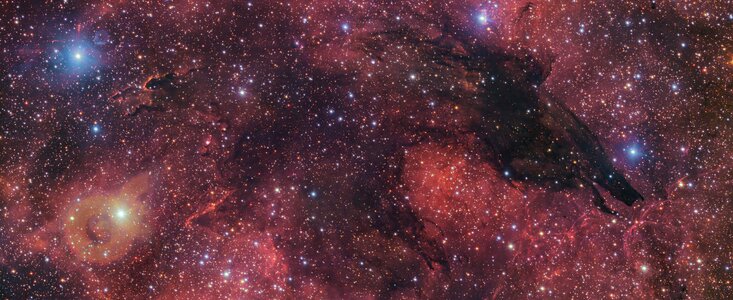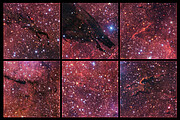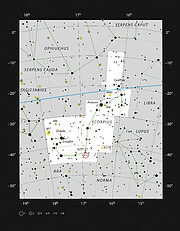Comunicato Stampa
Una nuova immagine dell'ESO cattura in cielo un tenebroso lupo
31 Ottobre 2024
Per Halloween, l'ESO (Osservatorio Europeo Australe) rivela questa spettrale immagine di una nebulosa oscura che crea l'illusione della silhouette di un lupo su un variopinto sfondo cosmico. Soprannominata opportunamente Nebulosa del Lupo Oscuro, è stata catturata in un'immagine da 283 milioni di pixel dal telescopio VST (VLT Survey Telescope) presso l'Osservatorio dell'ESO a Paranal in Cile.
Situata nella costellazione dello Scorpione, in una direzione vicina al centro della Via Lattea, la Nebulosa del Lupo Oscuro si trova a circa 5300 anni luce dalla Terra. Questa immagine occupa un'area di cielo equivalente a quattro Lune piene, ma in realtà fa parte di una nebulosa ancora più grande chiamata Gum 55. Se guardate bene, il lupo potrebbe persino essere un lupo mannaro, con le mani pronte ad afferrare ignari passanti...
Se pensavate che l'oscurità equivalesse al vuoto, è ora di ripensarci. Le nebulose oscure sono fredde nubi di polvere cosmica, così dense da oscurare la luce delle stelle e degli altri oggetti dietro di loro. Come suggerisce il nome, non emettono luce visibile, a differenza di altre nebulose. I granelli di polvere al loro interno assorbono la luce visibile e lasciano passare solo radiazioni a lunghezze d'onda maggiori, come la luce infrarossa. Gli astronomi studiano queste nubi di polvere congelata perché spesso contengono nuove stelle in formazione.
Naturallmente, è possibile trovare la figura spettrale del lupo in cielo solo perché contrasta con uno sfondo luminoso. Questa immagine mostra in modo spettacolare come il lupo scuro si staglia contro le nubi luminose con formazione stellare sullo sfondo. Le nubi variopinte sono costituite principalmente da idrogeno gassoso e brillano di toni rossastri per l'eccitazione provocata dall'intensa radiazione UV delle stelle neonate al loro interno.
Alcune nebulose oscure, come la Nebulosa Sacco di Carbone, sono visibili a occhio nudo –– e svolgono un ruolo chiave nel modo in cui i popoli delle Prime Nazioni interpretano il cielo [1] –– ma questo non è il caso per il Lupo Oscuro. Questa immagine è stata creata utilizzando i dati del VST, il VLT Survey Telescope, di proprietà dell'Istituto Nazionale di Astrofisica in Italia (INAF) e ospitato presso l'Osservatorio dell'ESO al Paranal, nel deserto di Atacama in Cile. Il telescopio è dotato di una fotocamera appositamente progettata per mappare il cielo meridionale in luce visibile.
L'immagine è stata prodotta a partire da immagini scattate in momenti diversi, ciascuna con un filtro che lascia passare un diverso colore della luce, durante la realizzazione della survey VPHAS+ (VST Photometric Hα Survey of the Southern Galactic Plane and Bulge), che ha studiato circa 500 milioni di oggetti nella Via Lattea. Survey come questa aiutano gli scienziati a comprendere meglio il ciclo di vita delle stelle nella nostra galassia e i dati ottenuti sono resi pubblici tramite il portale scientifico dell'ESO. Esplorate voi stessi questo tesoro di dati: chissà quali altre forme inquietanti riuscirete a scoprire nell'oscurità?
Note
[1] Il popolo Mapuche del Cile centro-meridionale si riferisce alla Nebulosa Sacco di Carbone come ‘pozoko’ (pozzo d’acqua), mentre gli Inca la chiamavano ‘yutu’ (un uccello simile alla pernice).
Ulteriori Informazioni
L'ESO (European Southern Observatory o Osservatorio Europeo Australe) consente agli scienziati di tutto il mondo di scoprire i segreti dell'Universo a beneficio di tutti. Progettiamo, costruiamo e gestiamo da terra osservatori di livello mondiale - che gli astronomi utilizzano per affrontare temi interessanti e diffondere il fascino dell'astronomia - e promuoviamo la collaborazione internazionale per l'astronomia. Fondato come organizzazione intergovernativa nel 1962, oggi l'ESO è sostenuto da 16 Stati membri (Austria, Belgio, Danimarca, Francia, Finlandia, Germania, Irlanda, Italia, Paesi Bassi, Polonia, Portogallo, Regno Unito, Repubblica Ceca, Spagna, Svezia e Svizzera), insieme con il paese che ospita l'ESO, il Cile, e l'Australia come partner strategico. Il quartier generale dell'ESO e il Planetario e Centro Visite Supernova dell'ESO si trovano vicino a Monaco, in Germania, mentre il deserto cileno di Atacama, un luogo meraviglioso con condizioni uniche per osservare il cielo, ospita i nostri telescopi. L'ESO gestisce tre siti osservativi: La Silla, Paranal e Chajnantor. Sul Paranal, l’ESO gestisce il VLT (Very Large Telescope) e il VLTI (Very Large Telescope Interferometer), così come telescopi per survey come VISTA. Sempre a Paranal l'ESO ospiterà e gestirà la schiera meridionale di telescopi di CTA, il Cherenkov Telescope Array Sud, il più grande e sensibile osservatorio di raggi gamma del mondo. Insieme con partner internazionali, l’ESO gestisce APEX e ALMA a Chajnantor, due strutture che osservano il cielo nella banda millimetrica e submillimetrica. A Cerro Armazones, vicino a Paranal, stiamo costruendo "il più grande occhio del mondo rivolto al cielo" - l'ELT (Extremely Large Telescope, che significa Telescopio Estremamente Grande) dell'ESO. Dai nostri uffici di Santiago, in Cile, sosteniamo le operazioni nel paese e collaboriamo con i nostri partner e la società cileni.
La traduzione dall'inglese dei comunicati stampa dell'ESO è un servizio dalla Rete di Divulgazione Scientifica dell'ESO (ESON: ESO Science Outreach Network) composta da ricercatori e divulgatori scientifici da tutti gli Stati Membri dell'ESO e altri paesi. Il nodo italiano della rete ESON è gestito da Anna Wolter.
Links
- Fotografie dei telescopi per survey, tra cui il VST, al Paranal
- Per i giornalisti: iscrivetevi per ricevere i nostri comunicati sotto embargo nella vostra lingua
- Per i ricercatori: avete una storia da raccontare? Inviateci il vostro articolo scientifico
Contatti
Juan Carlos Muñoz Mateos
ESO Media Officer
Garching bei München, Germany
Tel.: +49 89 3200 6176
E-mail: jmunoz@eso.org
Bárbara Ferreira
ESO Media Manager
Garching bei München, Germany
Tel.: +49 89 3200 6670
Cell.: +49 151 241 664 00
E-mail: press@eso.org
Anna Wolter (press contact Italia)
Rete di divulgazione scientifica dell'ESO
e INAF-Osservatorio Astronomico di Brera
Milano, Italy
Tel.: +39 02 72320321
E-mail: eson-italy@eso.org
Sul Comunicato Stampa
| Comunicato Stampa N": | eso2416it |
| Nome: | Dark Wolf Nebula |
| Tipo: | Milky Way : Nebula : Type : Star Formation |
| Facility: | VLT Survey Telescope |
Our use of Cookies
We use cookies that are essential for accessing our websites and using our services. We also use cookies to analyse, measure and improve our websites’ performance, to enable content sharing via social media and to display media content hosted on third-party platforms.
ESO Cookies Policy
The European Organisation for Astronomical Research in the Southern Hemisphere (ESO) is the pre-eminent intergovernmental science and technology organisation in astronomy. It carries out an ambitious programme focused on the design, construction and operation of powerful ground-based observing facilities for astronomy.
This Cookies Policy is intended to provide clarity by outlining the cookies used on the ESO public websites, their functions, the options you have for controlling them, and the ways you can contact us for additional details.
What are cookies?
Cookies are small pieces of data stored on your device by websites you visit. They serve various purposes, such as remembering login credentials and preferences and enhance your browsing experience.
Categories of cookies we use
Essential cookies (always active): These cookies are strictly necessary for the proper functioning of our website. Without these cookies, the website cannot operate correctly, and certain services, such as logging in or accessing secure areas, may not be available; because they are essential for the website’s operation, they cannot be disabled.
Functional Cookies: These cookies enhance your browsing experience by enabling additional features and personalization, such as remembering your preferences and settings. While not strictly necessary for the website to function, they improve usability and convenience; these cookies are only placed if you provide your consent.
Analytics cookies: These cookies collect information about how visitors interact with our website, such as which pages are visited most often and how users navigate the site. This data helps us improve website performance, optimize content, and enhance the user experience; these cookies are only placed if you provide your consent. We use the following analytics cookies.
Matomo Cookies:
This website uses Matomo (formerly Piwik), an open source software which enables the statistical analysis of website visits. Matomo uses cookies (text files) which are saved on your computer and which allow us to analyze how you use our website. The website user information generated by the cookies will only be saved on the servers of our IT Department. We use this information to analyze www.eso.org visits and to prepare reports on website activities. These data will not be disclosed to third parties.
On behalf of ESO, Matomo will use this information for the purpose of evaluating your use of the website, compiling reports on website activity and providing other services relating to website activity and internet usage.
Matomo cookies settings:
Additional Third-party cookies on ESO websites: some of our pages display content from external providers, e.g. YouTube.
Such third-party services are outside of ESO control and may, at any time, change their terms of service, use of cookies, etc.
YouTube: Some videos on the ESO website are embedded from ESO’s official YouTube channel. We have enabled YouTube’s privacy-enhanced mode, meaning that no cookies are set unless the user actively clicks on the video to play it. Additionally, in this mode, YouTube does not store any personally identifiable cookie data for embedded video playbacks. For more details, please refer to YouTube’s embedding videos information page.
Cookies can also be classified based on the following elements.
Regarding the domain, there are:
- First-party cookies, set by the website you are currently visiting. They are stored by the same domain that you are browsing and are used to enhance your experience on that site;
- Third-party cookies, set by a domain other than the one you are currently visiting.
As for their duration, cookies can be:
- Browser-session cookies, which are deleted when the user closes the browser;
- Stored cookies, which stay on the user's device for a predetermined period of time.
How to manage cookies
Cookie settings: You can modify your cookie choices for the ESO webpages at any time by clicking on the link Cookie settings at the bottom of any page.
In your browser: If you wish to delete cookies or instruct your browser to delete or block cookies by default, please visit the help pages of your browser:
Please be aware that if you delete or decline cookies, certain functionalities of our website may be not be available and your browsing experience may be affected.
You can set most browsers to prevent any cookies being placed on your device, but you may then have to manually adjust some preferences every time you visit a site/page. And some services and functionalities may not work properly at all (e.g. profile logging-in, shop check out).
Updates to the ESO Cookies Policy
The ESO Cookies Policy may be subject to future updates, which will be made available on this page.
Additional information
For any queries related to cookies, please contact: pdprATesoDOTorg.
As ESO public webpages are managed by our Department of Communication, your questions will be dealt with the support of the said Department.




